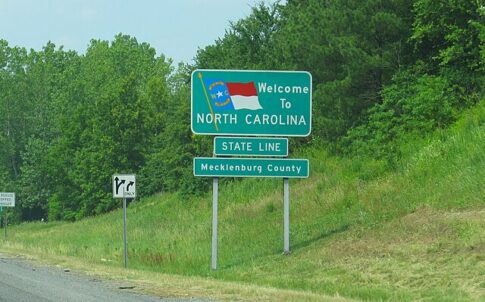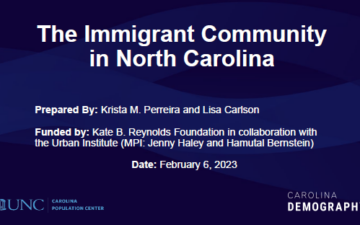The demographics of North Carolina’s foreign-born population

In recent weeks, we’ve received many data requests from journalists and community leaders across North Carolina about the state’s foreign-born population. This heightened interest is largely driven by concerns about how the new presidential administration’s policies may affect North Carolina. In this blog, we provide a demographic overview of the state’s foreign-born population.
Since 1990, the foreign-born population has grown by 763 percent.
According to the 2023 American Community Survey (ACS), there are an estimated 1,003,467 foreign-born residents who call North Carolina home, representing 9.3% of the state’s overall population and the 13th largest foreign-born population of any U.S. State. In 1990, by comparison, there were only ~116,000 foreign-born residents — less than 2% of the state’s population.
The share of the population that is foreign-born is high in both urban and rural areas across the state, but most foreign-born residents live in urban centers. The counties with the highest shares of foreign-born residents are Mecklenburg (16.5%), Durham (15.2%), and Wake (14.5%). However, the foreign-born share is also high in more rural counties such as Duplin (11.6%) and Sampson (10.6%), which are centers of agricultural crop production – an industry with a largely foreign-born Latino workforce.
North Carolina’s foreign-born population leans slightly more male and older than the state’s U.S.-born population. 50.1 percent of the foreign-born population is male compared to 49.9% of the U.S.-born population in NC.
The median age among foreign-born NC residents is 43 compared to 38 for U.S.-born residents. We can see in the figure above that the foreign-born population pyramid is narrow in the youngest and oldest age groups and widest in the center or the middle age groups. Most (82%) of foreign-born residents are in the working age groups (16-64), compared to 62% of U.S.-born NC residents.
This means that foreign-born residents have a substantial impact on the North Carolina economy. Since the 1990s, the share of foreign-born residents in the state’s workforce has consistently grown. Currently, foreign-born workers make up 12.2% of the state’s labor force.
Foreign-born residents not only have an impact on North Carolina’s communities and our economy, but their families will play an integral role in the future of North Carolina. About one out of every 5 of the state’s 2.3 million children under the age of 18 (486,000) have at least one foreign-born parent. The majority (84%) of children of immigrant parents are U.S.-born, and most of those children (76%) are native to North Carolina.
Almost 70 percent of the state’s foreign-born residents were born in either Mexico, Central America, and the Caribbean or Asia. Although not shown here, the two largest countries of origin are Mexico (22%) and India (9%).
Similarly, 71% identify their race and ethnicity as either Latino (47.3%) or Asian, Native Hawaiian, or Other Pacific Islander (23.8%).
Among the roughly 1 million foreign-born residents, 44% are naturalized citizens and 56% are not U.S. citizens.
We don’t have a direct estimate of the unauthorized population.
Included among the roughly 564,000 foreign-born residents who aren’t U.S. citizens, are non-citizen U.S. nationals, lawful permanent residents (green card holders), temporary migrants (such as foreign students and those in the U.S. on certain work visas), humanitarian migrants (such as refugees and asylees), and unauthorized migrants. This is not to say that there are 564,000 unauthorized immigrants in North Carolina. The number of unauthorized immigrants can be estimated using what immigration researchers refer to as the “residual method.” Using this method, the Migration Policy Institute estimated that there were 296,000 unauthorized residents in North Carolina in 2019. We will present updated estimates of the unauthorized population in North Carolina using 2023 data in an upcoming blog post.
The foreign-born population is a large and growing segment of North Carolina’s population, recently surpassing one million residents. Over the past 35 years, foreign-born residents have integrated into our state’s economy and urban and rural communities. Foreign-born workers constitute 12.2% of the state’s workforce and 21% of all children in North Carolina have at least one foreign-born parent. As such, foreign-born residents and their families are an important part of the state’s economy and communities and will play a critical role in the state’s future.
Need help understanding population change and its impacts on your community or business? Carolina Demography offers demographic research tailored to your needs.
Contact us today for a free initial consultation.
Contact UsCategories: Carolina Demographics, NC in Focus
Tags: foreign born, North Carolina, policy

The Center for Women’s Health Research (CWHR) at the University of North Carolina School of Medicine released the 12th edition of our North Carolina Women’s Health Report Card on May 9, 2022. This document is a progress report on the…

Dr. Krista Perreira is a health economist who studies disparities in health, education, and economic well-being. In collaboration with the Urban Institute, she recently co-led a study funded by the Kate B. Reynolds Foundation to study barriers to access to…

Our material helped the NC Local News Lab Fund better understand and then prioritize their funding to better serve existing and future grant recipients in North Carolina. The North Carolina Local News Lab Fund was established in 2017 to strengthen…
Your support is critical to our mission of measuring, understanding, and predicting population change and its impact. Donate to Carolina Demography today.